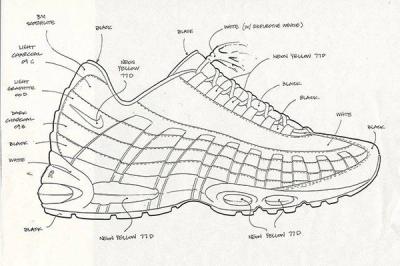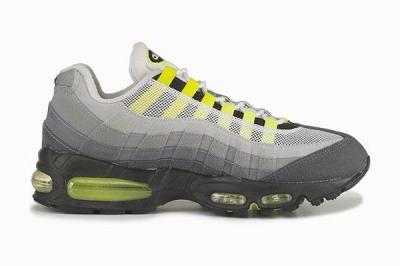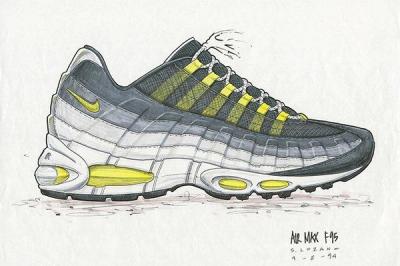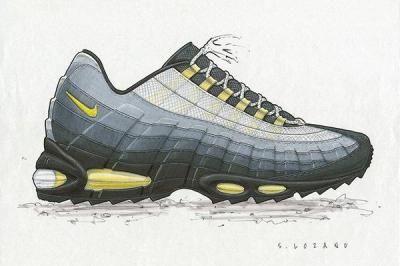Sergio Lozano On The Anatomy Of The Air Max 95
When this year rolled around we already knew it was gonna be a big one for retrospective celebration, with 2015 marking the anniversaries for a number of iconic designs, a testament to the golden age of sneaker design during that late '80s, mid '90s period. Nike dedicated the first six months celebrating their seminal Air Max 90 silhouette, but now their focus turns to another game changing Air Max, the 95. Created by upcoming footwear designer Sergio Lozano, the Air Max 95 was a watershed moment in the history of the Air Max range, a move away from Tinker Hatfield's restrained designs to flamboyant silhouettes that brought forth that crazy technical era of footwear design in the second half of the decade, a precursor to the wild designs of the 97, 98 and TN. On the 20th anniversary of the AM95, we sat down with Sergio Lozano to look back on his Air Max, delving into the history of the iconic sneaker that cemented Nike's fearless endeavour to innovate and push the boundaries of sneaker design.
When you started designing the Air Max 95 over twenty years ago, did you ever think you'd still be talking about it in 2015?
No way! As a designer, you actually do a project, and you do your best, put it out there, and you really don't know what's going to happen. You quickly move onto the next project.
Did you always want to work with performance sportswear?
No, actually, that's something that I fell into. I went to school to study industrial design. I studied design at Cal State in Long Beach, and when I was there Nike came recruiting. They were doing a west coast swing to hire just a bunch of young designers, and this was a time when Nike was growing like crazy at the very start of the ‘90s. I thought, "Okay Nike, I get it. That's kind of a cool brand, but I'm not sure if I want to design shoes. It's not really what I studied". So I applied for the job because I wanted interviewing experience, not because I wanted the job. I interviewed once, and apparently it went well, because when they came back again, they wanted to interview me a second time. Anyway, the second interview was actually pretty cool, I didn't know who these guys were at the time, but the people that came to interview me were Mark Parker, Tinker Hatfield, and Sandy Bodecker. At that point, I was still thinking, "Ah, I'm not sure if I would take the job, but I sure hope they offer me the job."
So long story short, in 1990 I ended up designing sneakers for Nike. And I thought I was going to be here for like two, maybe three years, and then move on to the next thing. So here I am, almost 25 years later. Having a blast, working for a great company, creating stuff. So that's my long answer. I thought it was going to be quick, but there you go. And that's how I landed the job.
The Air Max 95 would have been your really big breakout design. Visually, it was such a departure from Tinker's previous Air Max series. Did Nike request for a brand new look, or did you spearhead the change for the silhouette?
So, running, at the time was a big sport category for Nike, but definitely not as big as it is now. As a matter of fact, running was still the underdog of basketball back in the early '90s. So one of the goals was to take our top level running product, which was the Air Max, and really reinvent it to make a statement and take it to a new level. I wasn't part of the group already working on the Air Max at the time; I wasn't part of the team working on running. I was working on a couple of other categories, and what they decided to do was to get somebody to design it from outside of the category because they wanted a fresh perspective, they wanted to do something very different with the Air Max 95.
That's where I came in. I joined the team just to design this product and that's what we talked about. It was great, because the brief was pretty simple, design and develop this really great marquee performance shoe, but do something that we've never seen before. I was a little bit naive, because I was still relatively young and I didn't really know a lot about running other than seeing runners around the campus. That was really the goal, do something we’ve never seen before, so it was great. When we approached the product we kind of knew what we wanted to do, but then there were the specifics. How are we going to make this come together? How are we going to address the bottom of the shoe in terms of torsional rigidity and flexibility? How are we going to address this idea around fit and supporting the heel, and reflective materials? How are we going to solve this whole problem around support? All the functional things that we really wanted to provide for the athlete, with most performance designs it usually starts from solving these problems first.
The upper gets all the credit, but the air bag was a work of art. Did you work on the cushioning design?
The air soles were already well down the development and manufacturing pipeline so I didn’t work on the cushioning design. But the innovation team and I worked on the design around the air soles, deciding on the amount of visibility we wanted to create and carving out the weight around the polyurethane. And then ensuring that it was torsionally structural and rigid enough so it doesn’t flex where you don’t want it to.
Aside from the design of the Air Max 95 silhouette, the original colourways have become iconic themselves, how did they come about during the process?
Well, I was the guy who came up with the colour. Back then, we didn't have colour designers at the time. Now, we've got a whole host of colour designers that do all sorts of amazing things. But, back then if you were a product designer and you designed shoes, you did it all. The colour actually has a functional foundation to it. It wasn't just because we wanted to do a fade for aesthetic reasons. The colour was actually driven by an observation that we made.
We’re in Portland, Oregon, and it rains a lot, and while we were observing runners using our sneakers that were predominately white with white midsoles at the time, they got dirty real fast. So I was like, "What if we use the colour to kind of disguise some of the dirt that was created?" So that was pretty much it! That was the insight around flipping colours. Let’s start it with black at the bottom, hide the dirt, and then it just sort of fades into white!
Did all the original colourways you dreamt up make the final cut?
Yeah, we did experiment with a few other things. Actually, recently I was going through my folio of old sketches and I found the sketch of the Neon colourway that I first presented to everyone. I remembered one of the comments after I showed them was, "We will never do that colourway" (laughs).
That sketch is essentially exactly the colourway that we eventually debuted the original Air Max 95 in at the end, But it was very controversial at the time. And so we were asked to explore other ways to colour the shoes so it felt more like a traditional running shoe, which kinda defies the whole idea around doing something new and fresh, but did it anyway to keep them happy. Essentially we reversed it, so instead of stony black at the bottom, it started white and then faded to black on the top. We ended up sampling that concept, I know that sample exists somewhere….we're trying to find it still, believe it or not….
But essentially, the story kind of came together really, really fast. There's a lot of these interviews now, where people want to know if we're gonna reintroduce it, and it prompted me to go back to look at all the sketches. I realised that the shoe actually came together pretty quickly and we didn’t fuss about the colourway for very long, so yeah, there's the story.
There’s no huge Swoosh on the side. Was that at all controversial?
The whole shoe was controversial because it wasn’t your typical running shoe. So from the design to the color to the little swoosh, it all caused controversy. I had initially designed the shoe without a swoosh because we believed the design was aesthetically strong. We felt people would see it and say, only Nike will design that. But we needed the swoosh on there and adding it on top of the molding and webbing didn’t work so we positioned it as a signature, a sign off on the shoe.
Over the last twenty years, there’s been so many iterations, remixes and updated versions of your original design. What are your thoughts about these newer versions?
Honestly, I love them. I think sometimes we can hold things too preciously and not mess with them, and it's okay, if you're a purist, that's cool. But I like not keeping things so sacred and so precious, that it doesn't allow us to kind of experiment, because you might never know where you might discover experimenting. As long as you still got the OG in the line up and it still comes out, then cool, do whatever you want. Do all kinds of variations, and if some of those variations actually take, and it makes the OG drop off eventually, then that's fine too. I know there's a couple of new models that we're introducing, and having talked to a couple of the designers that have designed those new shoes, I think they've done a fantastic job of actually looking at it, being inspired, but then taking it to another place, to a new level.
It’s interesting to see the new Ultra Air Max 95. It’s so smooth it almost looks like a sculpture, rather than a shoe. What do you think about these edited versions of your original designs? (be honest!)
I think its fantastic that twenty years after the AM 95 first debuted, there is still interest in the footwear. With the Ultra, its very much AM 95 as soon as you look at it. A lot of the design elements are exactly the same with an inverse of colors. Its a great reminder of the DNA of the OG.
The Jacquard version is crazy too. Did you have much to do with them?
Ben Yun is the talented designer behind Jacquard. We had some conversations where I shared about the inspiration behind the OG. The color on the original was one-of-a-kind back then. Running shoes never used black midsoles prior to AM 95 but I wanted to use it because its functional. You can’t see dirt. Those conversations probably helped shape some of the design here. Ben did a great job in creating a unique, stand-alone design, while still keeping to the original Max 95 DNA. I can definitely see a strong connection but his product is strong on its own.
Given the current obsession with minimalism and monotone colours in performance sportswear, do you think that it's possible for a new sneaker to really blow people's minds like your design did back in 1995?
Absolutely. I totally believe that. It may not be as easy, but I believe it can be done. What I think sets brands apart and what I think sets Nike apart is that we're never satisfied, so we're in constant pursuit of something; a great product, great performance, the most technical, and then we innovate around that all the time. In that constant pursuit, when you find something that is so different and so unique that it actually does create ripple effects in the industry, that’s when the magic happens. And I think it does continue to happen, it just looks different these days, because sneaker culture, and the world is just more complex than it was back in the '90s.
I don't wanna wax philosophical on all that, but I do feel that the market is a lot more complex, but it's possible to still blow peoples minds and change the paradigm with great design, it’s just a little bit more difficult than it used to be.




